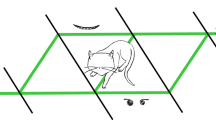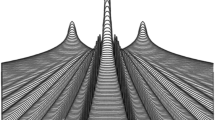Abstract
The object of this work is to analyze Summhammer's recent experimental test of the non-ergodic interpretation of quantum mechanics using neutron interferometry. We conclude that the experiment presents clear and concrete evidence that the ergodic type assumption, which must be made in virtually all the well known interpretations of quantum mechanics, is valid. That is, the physical assumption that particles which consecutively pass through an interference apparatus will be independent as long as they pass through the apparatus alone, now has experimental confirmation. The non-ergodic interpretation had been calling attention to the fact that hitherto there was no experimental evidence for this assumption.
Similar content being viewed by others
References
J. Summhammer, “Neutron interferometric test of the non-ergodic interpretation of quantum mechanics,”Nuovo Cimento 103B (3) (1989)
V. Buonomano, “The non-ergodic interpretation of quantum mechanics and neutron interferometry,”Physica B 151, 349–350 (1988).
V. Buonomano and A. F. Prado, “Stochastic processes for indirectly interacting particle and stochastic quantum mechanics,”Found. Phys. 18, 401 (1988).
V. Buonomano, “The non-ergodic interpretation of quantum mechanics,” inMicrophysical Reality and Quantum Formalism, A. van der Merwe, F. Selleri, and G. Tarozzi, eds. (Kluwer, Dordrecht, 1988).
V. Buonomano, “The EPR paradox and the non-ergodic interpretation of quantum mechanics,” inQuantum Mechanics Versus Local Realism: The Einstein, Podolsky, and Rosen Paradox, F. Selleri, ed. (Plenum, New York, 1988), pp. 327–343.
V. Buonomano, “The double-slit experiment and the non-ergodic interpretation of quantum mechanics,” inQuantum Uncertainties: Recent and Future Experiments and Interpretations, W. Honig, E. Panarella, and D. W. Kraft, eds. (Plenum, New York, 1987), pp. 427–434.
V. Buonomano and F. Bartmann, “Testing the ergodic assumption in the low-intensity interference experiments,”Nuovo Cimento 95B (2), 99–105 (1986).
V. Buonomano, “The number of photon counting measurements, the visibility and the intensity,”Lett. Nuovo Cimento 43 (2), 69–75 (1985).
V. Buonomano, “Quantum mechanics as a non-ergodic classical statistical theory,”Nuovo Cimento 57B, 146–170 (1980).
V. Buonomano, “Low intensity interference effects and hiddenvariable theories,”Nuovo Cimento 45B, 77–89 (1978).
V. Buonomano, “A limitation on Bell's inequality,”Ann. Inst. Henri Poincaré 29A, 379–394 (1978).
V. Buonomano, “Neutron interferometry and the non-ergodic interpretation of quantum mechanics,” unpublished.
H. Rauch and J. Summhammer, “Static versus time-dependent absorption in neutron interferometry,”Phys. Lett. 104 (1), 44–46 (1984).
J. Summhammer, H. Rauch, and D. Tuppinger, “Stochastic and deterministic absorption in neutron interference experiments,”Phys. Rev. A 36, 4447 (1987).
H. Margenau, “Measurements and quantum states: Part I,”Phil. Sci. 30, 1 (1963).
R. J. Glauber, “Optical coherence and photon statistics,” inQuantum Optics and Electroncs, C. de Witt, A. Blandin, and C. Cohen-Tannoudji, eds. (Gordon & Breach, New York, 1965), p. 63.
L. Mandel, “On the possibility of observing interference effects with light beams divided by a shutter,”JOSA 49, 931 (1959).
Author information
Authors and Affiliations
Additional information
1e.g., Copenhagen, statistical, Bohm, de Broglie, stochastic, and fluid interpretations.
2We restrict ourselves to strictly one-particle systems and interference experiments in this work.
3This is true in general and is not particular to quantum mechanics.
4This does not even mention the enormous difficulties involved in giving operational meaning to words such as “independent” and “identical.”
5Formally it differs from the usual interpretations only in that it associates the mathematical object xxxψ|A|ψxxx of the Hilbert space formalism with the laboratory procedure of making a time average instead of an ensemble average.
6The randomness of the shutter distinguishes this experiment from the so called chopper experiments [13, 14] which do not test NEI [12].
7We observe that the experiment may also be considered one in which the shutter is consecutively opened and closed but for random lengths of time. As such it is related to the experiment discussed by Mandel [17].
8This curve and the other curves in JS were made in the following way. Each run gave 20 experimental points of counts versus phase angle for each counter. These counts were normalized to compensate for the fact that the neutron intensity from the reactor was not constant during a given run. Then a curve fit was made separately for each run and the counts were calculated at 339 phase angles. These counts were then added at their respective phase angles producing a composite of all the runs. These counts were further normalized to one to produce the various probability curves shown in JS. In our own informal analysis, for convenience we used only 14 of the 19 runs which permitted us to add directly (after first normalizing for intensity variations) at their respective phase angle avoiding the necessity of performing the intermediate curve fits. In the various cases we compared this with the more accurate procedure of JS. No significant differences were seen.
Rights and permissions
About this article
Cite this article
Buonomano, V. Summhammer's experimental test of the non-ergodic interpretation of quantum mechanics. Found Phys Lett 2, 565–576 (1989). https://doi.org/10.1007/BF00692833
Received:
Issue Date:
DOI: https://doi.org/10.1007/BF00692833




